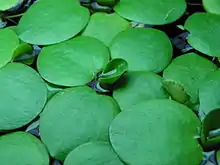Limnobium laevigatum
Limnobium laevigatum is a floating aquatic plant, and is a member of the family Hydrocharitaceae. Common names include West Indian spongeplant,[1] South American spongeplant and Amazon or smooth frogbit. This plant was introduced to North American waterways through use in aquariums and aquascapes.
| Limnobium laevigatum | |
|---|---|
 | |
| Scientific classification | |
| Kingdom: | Plantae |
| Clade: | Tracheophytes |
| Clade: | Angiosperms |
| Clade: | Monocots |
| Order: | Alismatales |
| Family: | Hydrocharitaceae |
| Genus: | Limnobium |
| Species: | L. laevigatum |
| Binomial name | |
| Limnobium laevigatum (Humb. & Bonpl. ex Willd.) Heine | |
Plant origin and distribution
Spongeplant originates from fresh water habitats of tropical and subtropical Central and South America. In California it has been introduced as an ornamental pond plant, and has escaped into greater waterways including areas surrounding Redding and Arcata, the Sacramento river delta and the San Joaquin River, and ponds and irrigation canals.
Description
Limnobium laevigatum is a floating aquatic plant, which can be mistaken for water hyacinth (Eichornia crassipes) due to their superficial similarity. Juvenile plants grow in rosettes of floating leaves that lie prostrate upon the water surface, a distinguishing character of the juvenile plant is the presence of spongy aerenchyma tissue upon the abaxial surface (underside) of the leaf. Mature plants grow up to 50 cm tall, and have emergent leaves borne on petioles that are not swollen or inflated like the spongy leaf stalks of water hyacinth, which aid in buoyancy. Spongeplant produces stolons which bear gametes. Flowers are small, white, and unisexual. Female flowers have an inferior ovary, the fruit is a fleshy capsule 4–13 mm long and 2–5 mm in diameter, and seeds are 1 mm long, ellipsoid, and hairy. Limnobium laevigatum, or Smooth Frogbit can be distinguished from Limnobium spongia, American frogbit, by flower and leaf characteristics as well as range; American frogbit is not known to occur in western states unlike smooth frogbit.
Plant reproduction
Limnobium laevigatum can reproduce and distribute sexually through flower pollination and seed production, and also vegetatively through fragmentation of stolon segments. The juvenile plants have a great capacity for distribution in that they are small, they float and can be easily and quickly carried along by water currents.
Aquascape use
Amazon Frogbit in captivity has two hazards to its health which aquarium owners can avoid: (1) water droplets on the tops of the leaves can rot the plant (they must be kept dry), and (2) some species of aquatic snail appear to like to eat the spongy material on the bottoms of the plant leaves (keep them near the center of the tank, not against the glass on the edges.)
Limnobium Management
California Department of Food and Agriculture (CDFA) crews which already manage other invasive aquatic plants including Hydrilla verticillata and Eichhornia crassipes have focused efforts upon Limnobium laevigatum. The CDFA has carried out detection and mapping of spongeplant throughout California, with a focus upon irrigation canals in the San Joaquin valley. Treatments have included mechanical and hand removal and application of appropriate aquatic herbicides including diquat and glyphosate upon remaining plants.
References
- "Limnobium laevigatum". Natural Resources Conservation Service PLANTS Database. USDA. Retrieved 21 June 2015.
| Wikimedia Commons has media related to Limnobium laevigatum. |
- DiTomaso, J. M. and E. Healy, 2003. Aquatic and Riparian Weeds of the West. University of California Division of Agriculture and Natural Resources publication number 3421. 6701 San Pablo Ave, Oakland, CA 94608-1239
- Anderson, Lars, and Pat Akers. "Spongeplant: A New Aquatic Weed Threat in the Delta." Cal-IPC News 19.1 (2011): 4-5. Print.
- Akers, Pat. The California Department Of Food and Agriculture Hydrilla Eradication Program Annual Progress Report 2009.